

We’ve rebranded to reflect who we’ve become: a science-based, privacy-focused proctoring platform designed for modern education, certification, and workforce assessments. OctoProctor represents our commitment to smarter, more adaptable, and test-taker-friendly remote proctoring.
Join Maria Larkin, OctoProctor’s communication specialist and an independent academic counselor, for a comprehensive proctoring tour for EU admission teams.
When it comes to admissions exams, we usually think about tertiary education. With the advance of AI-grade inflation and identity fraud, it makes sense to test whether a candidate is fit to undertake a program, especially if it is highly competitive and fast-paced. Ensuring the knowledge curve is consistent across domestic and international recruits makes sense regardless of whether the institution is selective or not.
I actually stayed at the same tertiary institution for all my degrees for several reasons, some of which were not my choice. Before settling in, I faced significant difficulties finding a university that suited my needs. At that time, you had to physically visit and pass entrance tests for the schools you wanted to be admitted into. I am a rather practical person, and I did not appreciate being subjected to such financial burdens just to pay a third-country price in the EU. So, offering remote proctored exams as an option for admission tests is actually my Roman Empire – I might be even a bit jealous as a veteran student and independent academic counselor. Yup, my CV is truly odd for a 27-year-old. Alas, all great things have pitfalls, be it my career or proctoring ;)

OctoProctor is against sacrificing integrity for access or vice versa. Proctoring technology has evolved significantly since the Ogletree v. Cleveland State room scans ruling, and so have the remote assessment methodologies and laws. Therefore, we (and personally I!) believe there is a need for a practical playbook for college admissions teams that addresses some of the concerns test-takers may have. Hopefully, more institutions will adopt online proctored exams as part of their admissions process after reading this article 🐙
Universities encounter entrance exams more frequently than schools or vocational programs. Standardized test examples include the SAT or ACT, which are nonetheless administered independently. In some countries, like Poland, Cyprus, and Italy, the state regulates and administers university entrance exams. But in many systems around the world, universities still conduct or require their own exams, such as Japan’s second-stage niji-shiken, Brazil’s university-specific Vestibular, the Philippines’ UPCAT/ACET/DCAT, Indonesia’s SIMAK UI, Bangladesh’s BUET test, Pakistan’s NUST NET, and various program-specific or institution-set assessments across Europe and the UK. The programs that require additional exams to reduce competition heavily depend on portability, cross-region and cross-border candidate accessibility, and the need for accommodations.

With rising geopolitical tensions and increasing domestic and international displacement, online higher education becomes an essential option that provides safety and future opportunities for students. Therefore, entrance exams help evaluate placement when previous academic information may be inaccessible.
Universities primarily focus on confirming pre-existing knowledge. This is necessary to ensure that a candidate both fits in with the cohort and is well-equipped to take on the first-year courses. Due to internationalization, entrance exams are a step that modern institutions cannot ignore if they want to secure the equality and prestige of the program. Let’s review some of the entrance exam types:
These exams, typically lasting no more than 90 minutes, either test subject knowledge to rank students for a specific program or determine if they need to complete a foundational year. This is especially important for students from countries where schooling lasts less than in the potential host country. When I applied for the BA program, I had to either take a foundation year and/or sit the SAT in addition to the three state exams I already passed. It was discouraging because I didn’t want to spend extra years, nor did I want to prepare for another stressful test, such as the SAT. On the other hand, how does my 11-year school education compare to the 14-year curriculum required in some Dutch institutions?
Some universities follow a single language of instruction, while others have multiple parallel language tracks. Some, like the Polytechnic University of Catalonia, offer mixed language programs. In any case, you need to demonstrate that you have sufficient language skills to understand the materials if you are not a native speaker or, in some cases, have not spent the last two-three years in secondary school in a place like New Zealand to be considered an adept English speaker. No shade to New Zealand, but towards EU institutions disregarding other countries than the great five (US, UK, CA, AU, and NZ) – Malta, Barbados, and the Majority of Caribbean nations where secondary education is conducted in English. And yes, being part of the Commonwealth does not lead to high school graduates having an average C1-C2 English level, as evidenced by Cyprus.
Most universities specify a list of third-party certifications they accept, along with a minimum score requirement. TOEFL, IELTS, and Cambridge English Qualifications should ring a bell when discussing what kinds of standardized tests are accepted as proof of knowledge. Thus, the most common minimum IELTS test score is 6,5 for EU undergrad admissions.
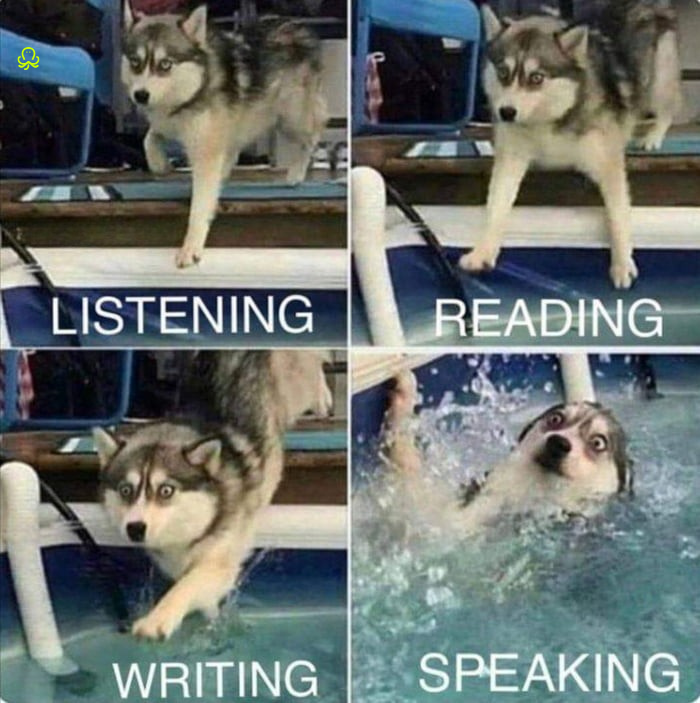
However, some universities allow students to pass a language test later in the admission process and take English 101 courses during the first one or two semesters if their language level is insufficient. In my opinion, this is a great alternative.
Extra exams concern merit or competition-based scholarships. Candidates either take an advanced exam that verifies their grades (especially important when dealing with candidates from countries known for grade bribery) or demonstrate their knowledge through a timed task. The said timed task is often a research proposal or essay meant to prove that scholarship recipients possess ethics and academic acumen above the Wikipedia, the free encyclopedia. Demonstrations can include a coding assignment, a live editing exercise, or a musical performance – the options are quite vast. Scholarship exams also carry higher prestige since you must earn them through considerable effort, compared to simply receiving one based on nationality, for example.
This is a more niche procedure compared to the entrance exams discussed above. Nevertheless, displacement is a sadly frequent occurrence today. Instead of subjecting already traumatized survivors to document recovery (extra problematic for mature learners whose degrees may not have been digitized), some institutions choose to test refugees' aptitude during a series of exams, saving time, money, and dignity.
Psychometric exams consist almost entirely of multiple-choice questions, with testing areas varying significantly across institutions. They are less common than language or aptitude entrance tests, but are a staple in corporate hiring. Some exams assess a candidate's potential for academic success by evaluating cognitive abilities like verbal reasoning, quantitative reasoning, problem-solving, and language comprehension, similar to IQ tests. Other psychometrics focus on measuring personality, behaviors, and emotional intelligence; this is where I believe we should draw the line in higher education, especially for undergrad admissions.

While emotional intelligence might be essential for nursing or medical programs, it could unnecessarily stress applicants to humanities or tech concentrations. I can only imagine some neurodiverse candidates faking behaviors and personality responses, feeling stressed, and guessing what the university expects from average neurotypical cohorts. IQ-like entrance tests are also questionable for neurodivergent individuals and may require extensive preparation with trial sessions to ensure comfort. There are no formulas or algorithms to reliably solve highly confusing and stressful diagrammatic reasoning tests.
Scale is the biggest factor, regardless of numerus fixus, private or public statuses. UNESCO reported that there are 264 million people enrolled in higher education worldwide in 2025 – more than double that in 2000. This dynamic reads like an epic win for education, and we must be prepared to respond to this demand. There is a lot of space for growth: 264 million people receiving their college degree equals just 3.22% of the entire world population. And, as the world demands more high-quality professionals, more people will be attracted to higher education to fulfill a better future dream.
Secondly, cross-border fairness. As mentioned earlier, different countries have different standards. This variation can be traced back to the school level – if you are a local, you would know which school is notoriously difficult and which one is easy on students. Remote proctored exams ensure everyone in the cohort meets the minimum requirements without the need to physically travel to an institution. While I understand that students who show up in person demonstrate their determination to get into a selective institution, this practice can be quite exploitative. For example, one of Italy's major polytechnic universities admits about 6,000 students per year, with around 10,000 candidates applying from around the world. Can you imagine 3,000 to 4,000 international students traveling to Italy just to take the entrance exam? Mad!
That would have been much easier and more environmentally friendly for both the planet and students if the university had chosen a proctored test instead of the test-in-the-lab format.
There are four pillars institutions can base their online proctored entrance exams on: identity verification, validity, accessibility, and due process. Each is customizable, flexible, and scale-focused, meaning it can work for years without major revisions.
OctoProctor is flexible when ot comes to identity assurance, and it is the institution that leads the way. Because there are different regulations across the globe, and in some cases, undergrad admissions deal with edge cases that are 16-17 years old, biometrics should be a no-go. Test taker can be checked through:
In any case, logs of identity events (who, when, how) should be properly compiled and accessible for appeals.
Firstly, the entrance university exam rules and test curriculum should be clear and accessible on the institution’s website before someone decides to apply and take a test. Proctoring should never come off as a surprise.
Secondly, the guidebook should clearly list permitted and forbidden aids, communication rules, device policies, and retake procedures, and it should be accessible to students, administrators, and proctors so everyone is on the same page.
Thirdly, use a 24–48-hour global window with randomized start times so entire cohorts aren’t taking the exam at the same time. Additionally, it will be considerate of candidates from regions with significant time differences from your institution. Nobody will feel comfortable taking a proctored exam at 5 AM, and it will directly affect the integrity of the admission process. To prevent question leakage — as we all know, test takers can team up online—deploy parallel or rotated forms, with at least four functionally equivalent versions, and include a few seed items to match difficulty. Lastly, clarify policies for late submissions and no-shows in advance so that students understand the risks.
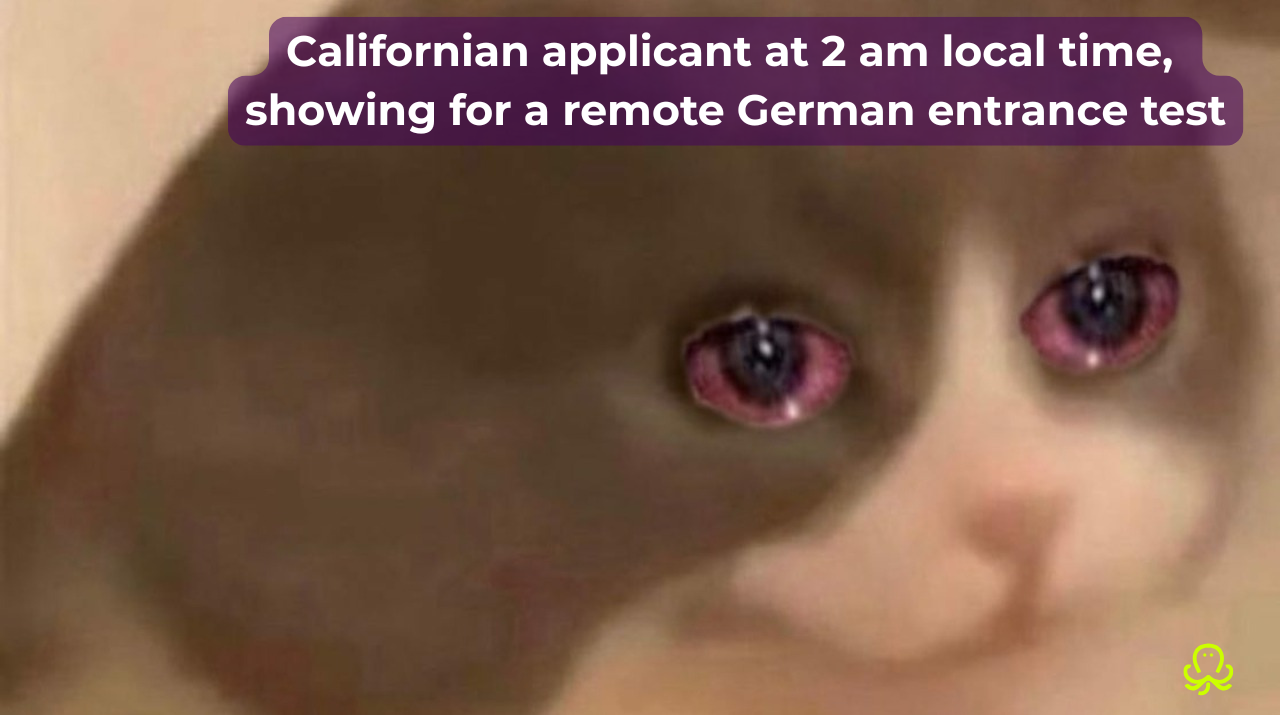
Asking for accommodation is common for differently-abled candidates, but it usually takes time to arrange, and time is a critical factor in admissions. What if I said that institutions can make exams equally accessible for candidates with disabilities and low-bandwidth users without “signaling” accommodations? Not groundbreaking, but definitely not an industry standard yet. Some other standards could be adopted without much fuss for anyone involved:
If someone sits an entrance exam, chances are it's for a highly competitive or demanding program at a reputable university. Some universities even set a limit on how many times you can apply in your lifetime – VU Amsterdam limits attempts for psychology programs to 2, and some of Erasmus University’s numerus fixus programs have a lifetime limit of 1 attempt. Imagine having only two attempts to get into your dream program – have you broken a sweat yet? That is why administrators must ensure that if the system flags an issue, candidates get a fair, timely, and clear review.
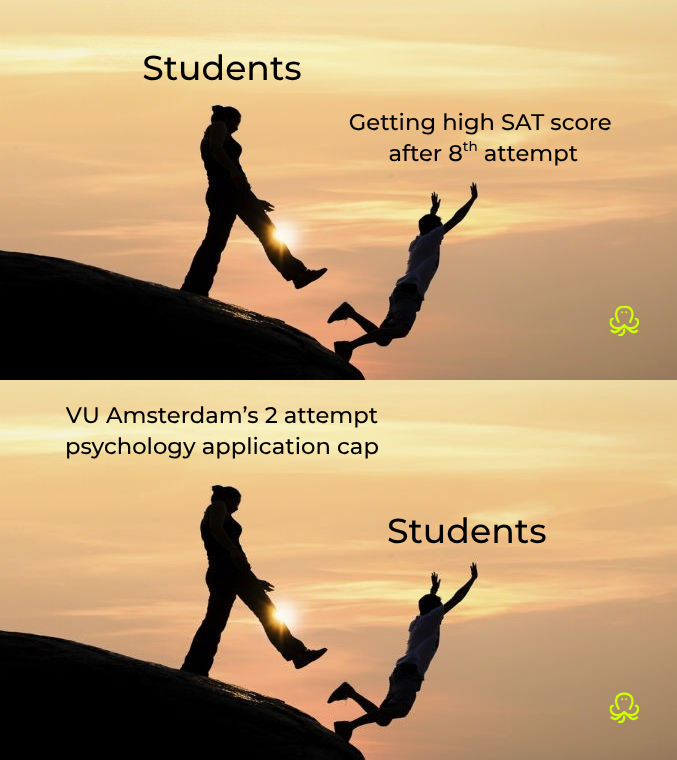
OctoProctor offers auto, AI, or live proctoring, which can be combined. Students might not appreciate it if only the algorithm determines their outcome (yes, that's dramatic), but what about humans who could be frankly irrational? I wouldn't recommend relying solely on one type of proctoring for admissions or scholarship exams.
In cases where the exam is purely a knowledge check, I see automated signal detection combined with mandatory human review for any adverse decision as the default. In other words, if someone scores below the integrity threshold, they are reviewed. If all results are satisfactory and no specific flags are present, there's no need for re-check.
In cases where an exam is part of a competition, I see a hybrid auto + live + record-and-review system to minimize any human factor in live proctoring.
In any case, proctors should avoid being too distracting. First, excessive supervision can interfere with students' focus and cut into their exam time. Second, the high stakes often lead to increased emotional reactions from both students and proctors.
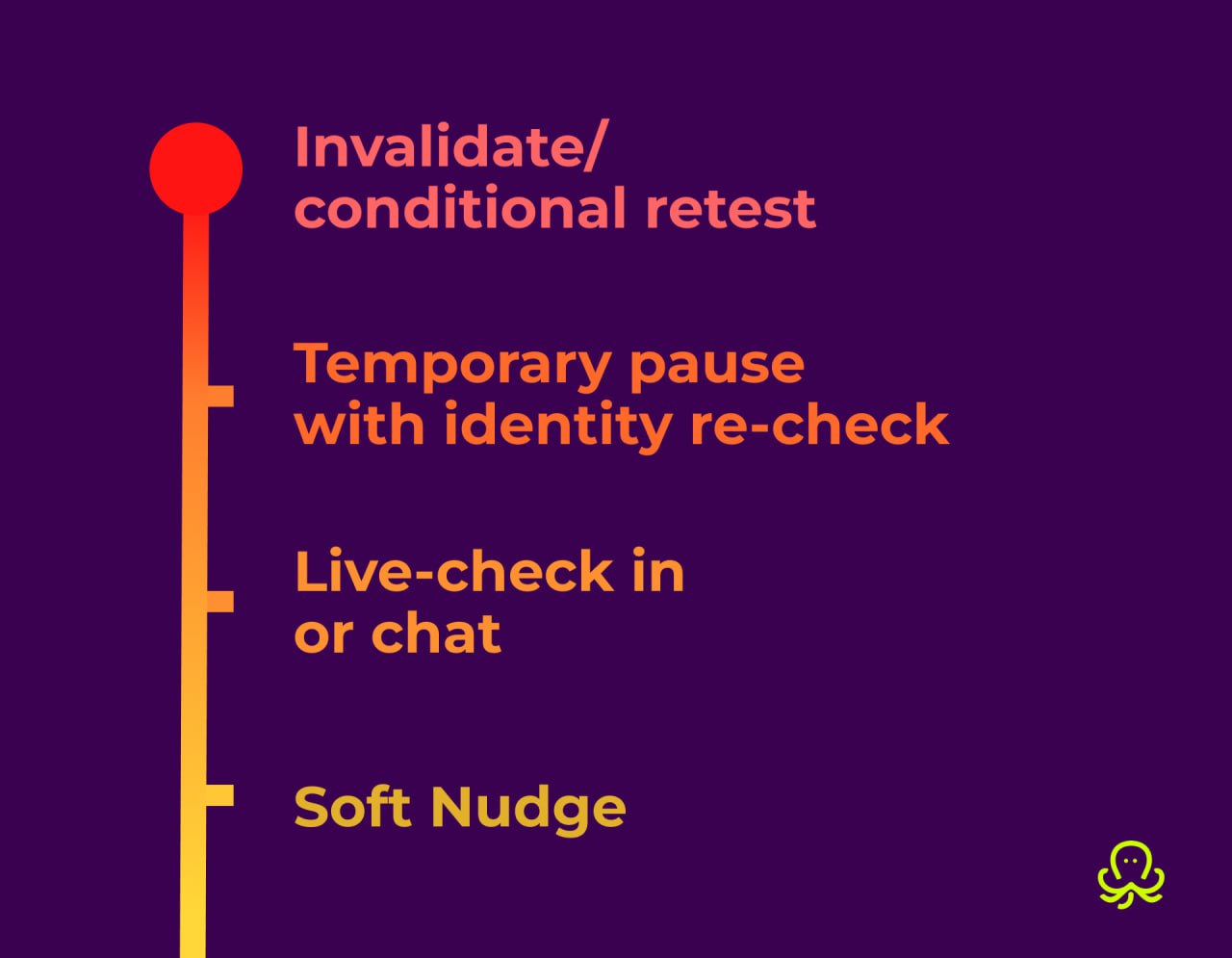
Institutions should define upfront what triggers action so that proctors, administrators, and auditors are all on the same page. Of course, best practice should be instructing test takers on what will flag them. While some incidents, such as “additional person detected,” fall under common sense, we should also account for stress and neurodivergency. Producing a short educational video on how to use proctoring, in addition to a mock proctored exam and official PDF documentation publicly accessible on the institutional website and applicant intranet, goes a long way.
Non-material – log only
Material – review, possible intervention
For each material event, institutions should specify the default response (nudge → verify → pause) and the type of evidence collected (clip, logs, proctor note).

Possibly the riskiest part for all parties involved – communication during high-stakes events going south. What is too strict, what is too vague, what is too friendly, etc? The great news is that you can now set lightweight chatbots with OctoProctor that will respond to students when the right keyword is triggered. Additionally, message drafts can be pre-designed for proctors to use during different situations. Pre-determined responses help human proctors to be timely while dealing with numerous support cases. Proctors should be as neutral as possible in their rhetoric, and culturally odorless for the sake of test taker’s peace – no “dears” or other endearments that can be seen as harassment instead of kindhearted support.
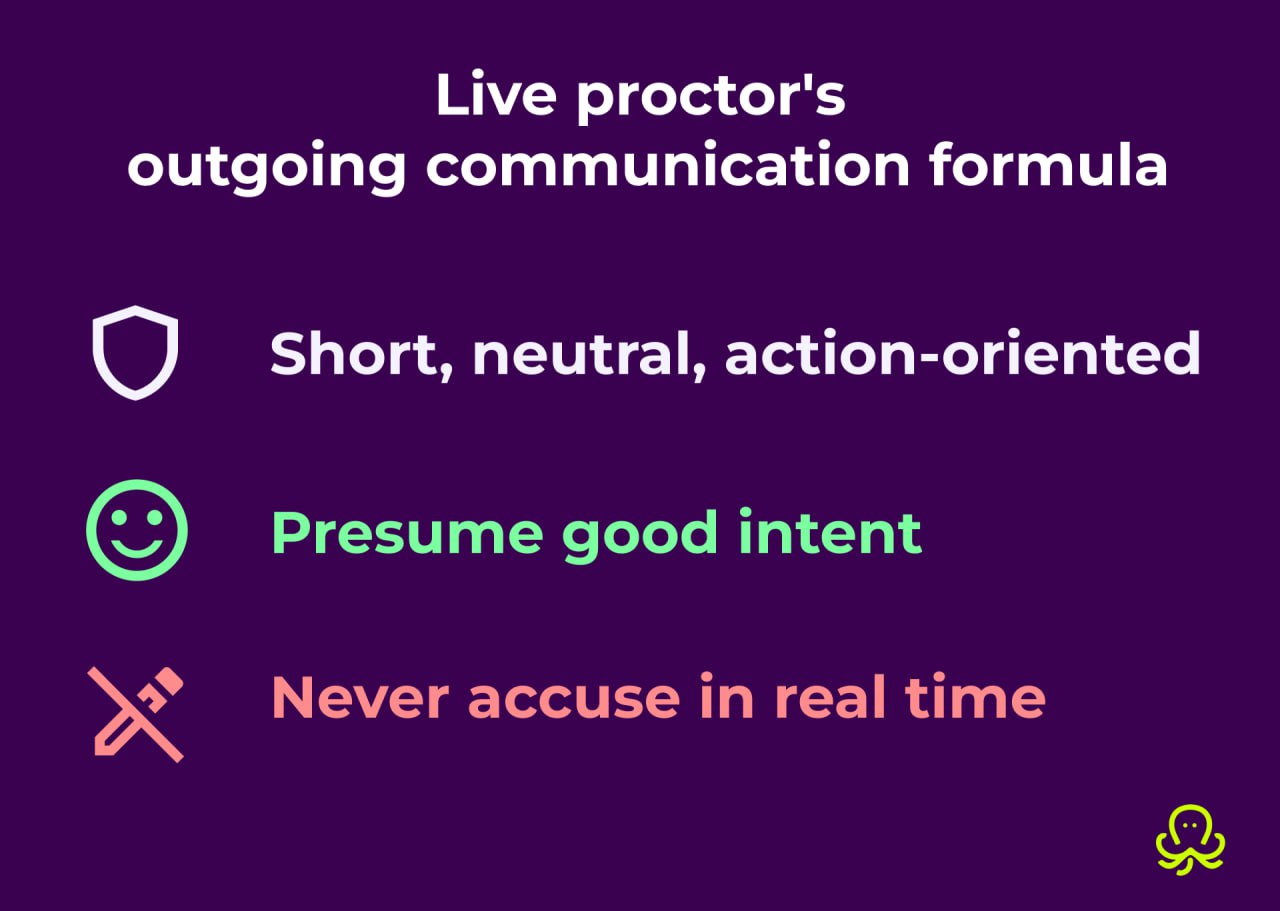
Unstable connections are a widespread issue in certain regions. Hence, your proctoring vendor must support the lowest bandwidth possible to accommodate a truly international cohort. OctoProctor supports internet connections as low as 256 kbps, and I think it is one of our paramount features when it comes to finding a partner in admission integrity. What if a student still goes offline?
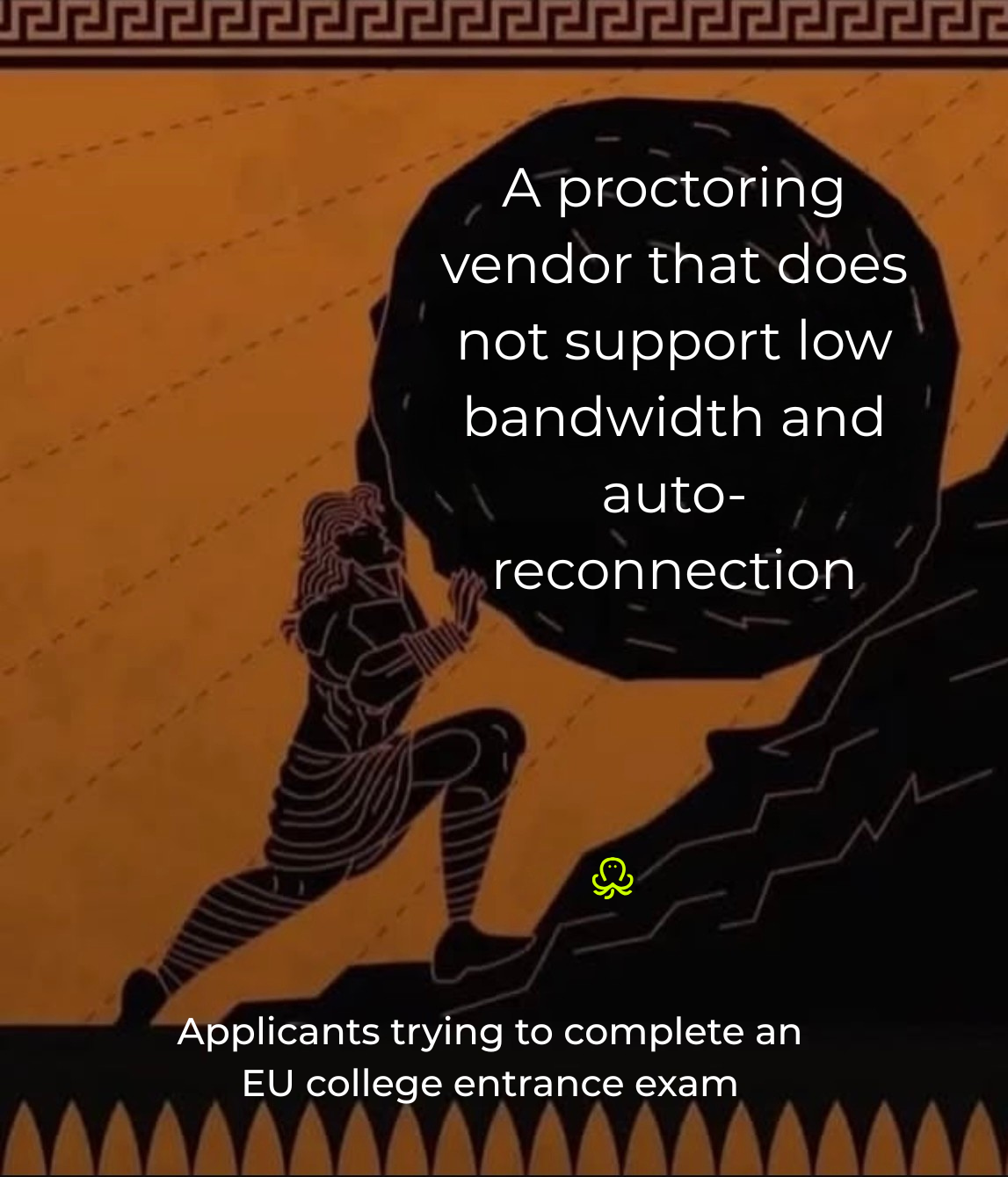
Universities are not exempt from laws and regulations just because they deal with consenting adults. Legal compliance for entrance-exam proctoring hinges on minimizing biometrics, maintaining human oversight, honoring ADA/504 accommodations within WCAG-compliant flows, and aligning transfers and retention with GDPR/CPRA (and student privacy laws), while providing non-intrusive alternatives to room scans, especially at state tertiary institutions.
There are enough horror stories online, with dedicated proctoring critics fueling distrust. Frankly, some of these stories are outdated, stemming from COVID-era chaos when no one was prepared for an overnight shift to online education. Nearly 6 years later, proctoring technology and its regulations have evolved considerably. That is why I always emphasize that an institution’s role lies in transparency and clear, friendly communication. Acknowledge the laws and explain how you are complying with them in clear, plain language, rather than hiding behind a 30-page PDF filled with legalese.
I have compiled the key laws and regulations you need to be aware of when planning remote proctored admission tests:
When done right, proctoring boosts trust in results, provides scalable access, cuts travel and administrative expenses, expands the talent pool, and ensures auditability. In competitive programs, proctoring prevents bribery and favoritism, offering a fair chance for students without large financial investments and minimizing disruptions to the learning process. Therefore, proctoring entrance exams becomes a matter of institutional responsibility and prestige.
Nobody enjoys exams, no matter the form. The student tension surrounding proctoring software isn't about supposed panopticism, but rather about how some proctoring providers and institutions miscommunicate the process. Anything can seem scary and uninviting; it depends on how you represent your product as a vendor. Unfortunately, in the proctoring industry, when one vendor has a major failure, negativity is directed at all of us. Then, we have to communicate our way out of someone else’s mess and collectively restore sentiment around the service we all sell. The self-check question a proctoring vendor should ask themselves, “how much power do we truly have as a third-party vendor when it comes to high-stakes exams?”
Of course, we at OctoProctor can recommend or educate our clients, but only up to a certain point. Therefore, it is ultimately up to institutions to explain why proctored exams are necessary and how everyone benefits from this experience, rather than viewing it as a predicament.
No, there are no standardized thinking skills assessments you can pass to get the entirety of the EU/EEA zone covered, like you would do with IELTS. Some countries have a standardized skill assessment for different majors, like Italian TOLC. Or, there are country-specific popular aptitude assessments supported by a group of universities. For example, if you are applying to a medical program in Germany, you can opt to pass the TMS, which is used by a total of 64 medical programs for admission as part of the German Higher Education Act.
No, none of the EU colleges and universities need TSA. Only two universities in the UK require TSA as part of the entry requirements to some undergraduate courses – the University of Cambridge and the University of Oxford.
No, college entrance exam reviewer is not a term used by EU institutions. Universities that rely on their own entrance exams may publish a curriculum for test takers to prepare. A college entrance exam reviewer is a practice mostly found in Asia.
Yes, both AP and SAT exam results are valid in the EU. In some competitive EU universities and numerus fixus programs, major subjects AP is a critical admission prerequisite for US applicants. Always check with your chosen institution – some have own guidelines, while others rely on standardized national baselines, like in the Netherlands, where NUFFIC should be your first point of reference for diploma equivalency.
Do you know why some counselors and admission mentors love EU universities so much? Because the EU institutions do not require SAT or ACT exams as a hard entrance requirement. Some establishments, like Italian Sapienza University or Spanish IE University, list SAT as an optional undergrad entrance requirement or alternative to the national exam, particularly for non-EU students. That’s it.
Yes, TOEFL iBT and TOEFL iBT Home Edition are both proctored exams popular around the world. Note that OctoProctor has no relation to TOEFL.
EU institutions do not rely on composite scores. If the entrance is based on merit, admissions will consider your GPA/CPA and separate grades earned in the subjects considered major for the chosen program.
What makes one cheat, and what breaks one from the cycle? Maria Larkin’s villain-worth origin story proves that communication can transform integrity from a death drive tool to a cultural mission filled with compassion.
From DIY systems and Linux to creating OctoProctor, secure assessment integrity software that handles 1m+ exams a year – Anton Skshidlevsky invites you to join a journey in time, programming, and academic rigor of EdTech founder.